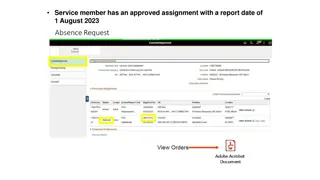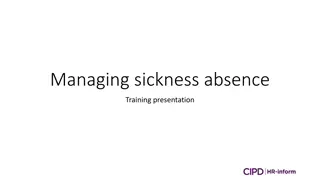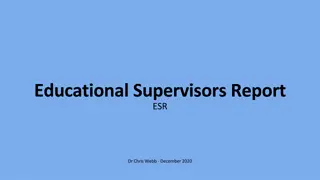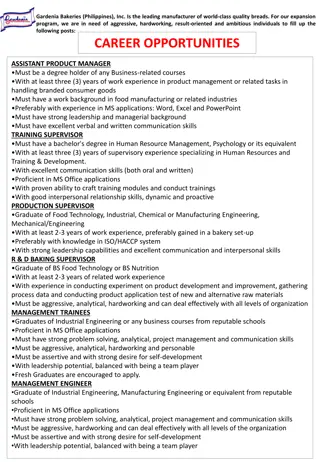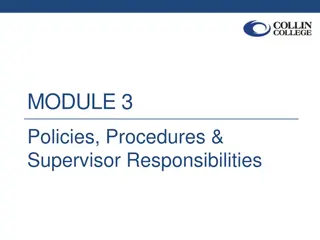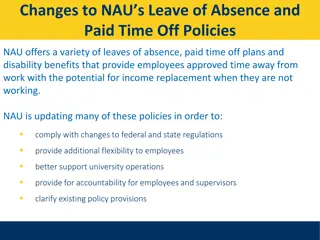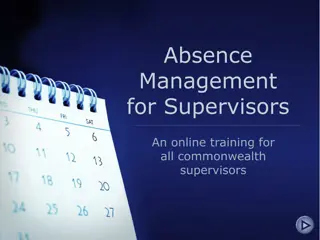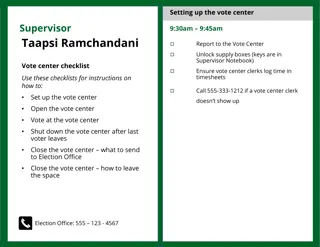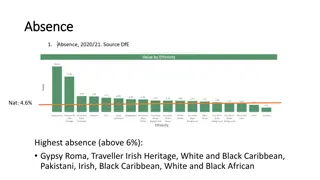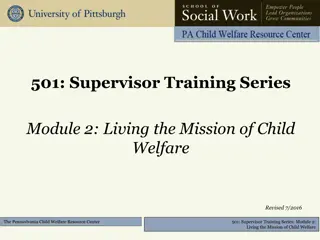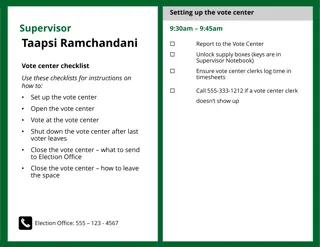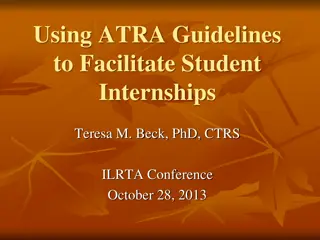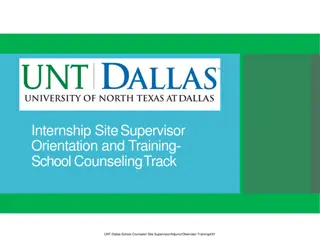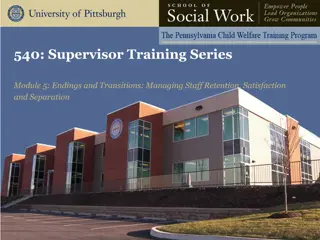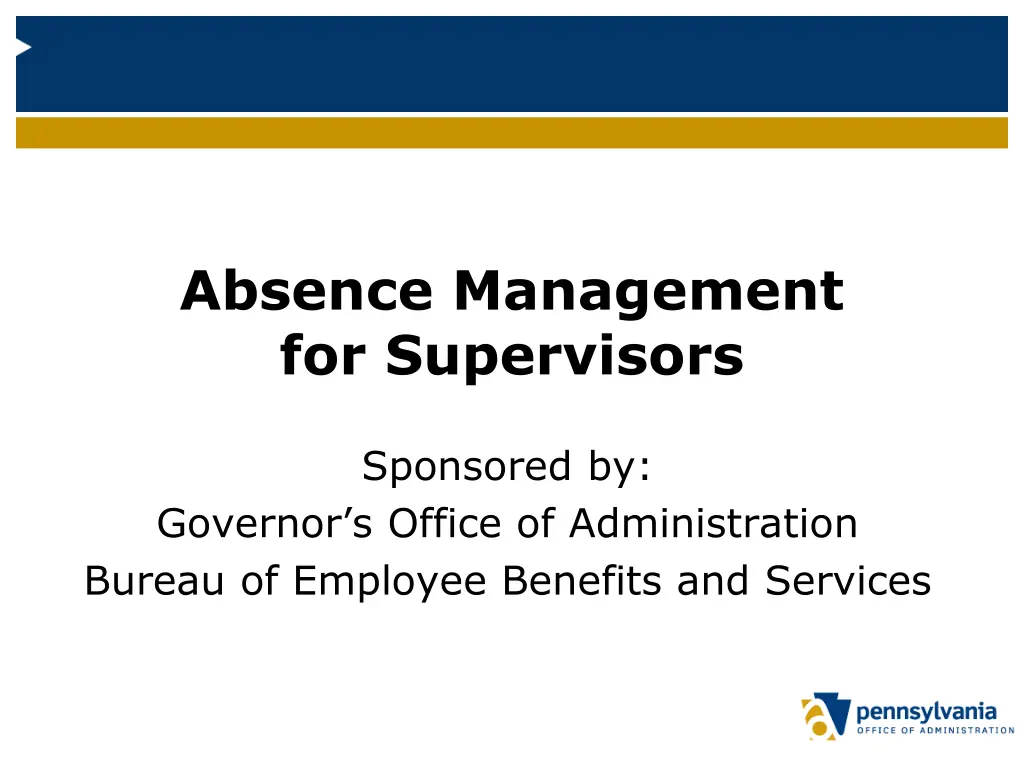
Effective Absence Management Guide for Supervisors
Discover the essentials of managing employee absences, including roles and responsibilities, FMLA guidelines, and promoting workplace efficiency. Get insights on why absence management matters, employee responsibilities, and more.
Download Presentation

Please find below an Image/Link to download the presentation.
The content on the website is provided AS IS for your information and personal use only. It may not be sold, licensed, or shared on other websites without obtaining consent from the author. If you encounter any issues during the download, it is possible that the publisher has removed the file from their server.
You are allowed to download the files provided on this website for personal or commercial use, subject to the condition that they are used lawfully. All files are the property of their respective owners.
The content on the website is provided AS IS for your information and personal use only. It may not be sold, licensed, or shared on other websites without obtaining consent from the author.
E N D
Presentation Transcript
Absence Management for Supervisors Sponsored by: Governor s Office of Administration Bureau of Employee Benefits and Services
Course Learning Objectives To provide a basic understanding of Absence Management A Supervisor s Role FMLA Absences Commonwealth Absence Provisions SPF Absence Responsibilities Who to Contact for Assistance
Course Layout Module 1: Absence Management Basics Module 2: Focus on a Supervisor s Role Module 3: FMLA Qualifying Absences Module 4: Application of SPF Absence
Module 1: Absence Management Basics
Absence Management Defined The dual responsibility of both the employee and supervisor to ensure absences are managed within an employee s leave balance quotas and entitlements and the commonwealth s absence provisions while maintaining operational efficiency.
Why is Absence Management important to you and your employees?
Importance of Absence Management Promotes positive office morale through fair and equal treatment of employees Reduces the need for overtime work Increases the efficiency of your operations and makes your job easier
Roles and Responsibilities Employee Supervisor Human Resource Office staff
Employee Responsibilities Manage leave within absence quota balance limits Request absences in advance, whenever possible Schedule absences at times least disruptive to operations whenever possible Obtain/provide supporting absence documentation as required Adhere to established call-off procedures and attendance work rules Request to use leave in accordance with established policies and procedures
How should employees learn about their responsibilities?
Supervisor Responsibilities Maintain efficient operations Apply the call-off policy consistently Have an understanding of absence types Ensure leave is entered for all absences Timely approve or deny leave requests Monitor absences and counsel employees about leave usage as needed Administer discipline as necessary
Human Resource Responsibilities Time Advisors, SPF Coordinators, and Labor Relations Coordinators within the Human Resource Office are responsible for: Providing guidance to employees and supervisors Administering absence policy Ensuring correct processing in SAP
Summary of Module 1: Absence Management Basics The employee, supervisor and Human Resource staff all have roles and responsibilities for effective absence management. The supervisor has a responsibility to assist in educating employees about absence policy and procedures and administer discipline as necessary.
Course Progress Module 1: Absence Management Basics Module 2: Focus on a Supervisor s Role Module 3: FMLA Qualifying Absences Module 4: Application of SPF Absence
Module 2: Focus on a Supervisor s Role
Focus on a Supervisors Role We will look at your role in Adhering to a call-off policy Understanding absence types Timely approving/rejecting leave requests Counseling employees
Adhering to the Call-off Policy Every organization needs one Must be standard and consistent May be different between organizations based on work performed Consult with the Human Resource Office when developing procedures
Understanding Absences Types Paid absences with accrued and anticipated leave Paid absences for other qualifying reasons Unpaid absence Extraordinary absences
Exercise What type of leave would you approve for
What should you consider before approving a leave request?
Timely Approving/Rejecting Requests Employees must request approval of all absences Absence requests should be made in advance whenever possible Emergency requests should be carefully considered for approval/disapproval in accordance with worksite priorities Each request should be reviewed on its own merits Criteria used in review should be applied consistently for all employees Know the time frame for approving absences in accordance with the union contract
Consider this scenario Assume operations would not allow leave to be approved, but Mary calls to tell you that her son called her on her way to work to let her know that he missed the bus. You know Mary s son will be home all day alone if she doesn t take him to school.
Timely Approving/Rejecting Requests Unsure it should be approved? After learning the reason for a leave request or call-off, verify whether the absence should be approved For a call-off, it is appropriate to ask for a telephone number to call the employee back if you feel you need to consult with others prior to approval/disapproval
Timely Approving/Rejecting Requests Can absences be disapproved? DON T BE AFRAID TO SAY NO!! Supervisors control approval of Annual and Personal Leave, based on operational needs Employees must be notified of disapproval and consequences Note: Supervisors may want to discuss issues with Labor Relations staff before denying leave.
Timely Approve/Reject Requests How is a call-off disapproved? You are needed at work because [project needs to be completed, another employee is scheduled to be off today, etc. OR you have no absence quota available to use] Therefore, I am disapproving your request to be absent, and this is a direct order to report to work. Failure to do so may result in disciplinary action. Note: Before using this script consult Labor Relations staff.
Call-Off Role Play Which response denies a leave request in a call-off situation
Counseling Employees Counsel as soon as a concern is obvious and After the counseling, follow-up as appropriate Consult with Labor Relations Review absence records on a regular basis/after each call off Approve or reject reasons for absence Record absences as AWOL if not approved Discipline as required
When in Doubt Call the Human Resource Office
Why is it important to ensure all employees receive absence management education?
Summary of Module 2: Focus on Supervisor s Role Supervisors must adhere to call off policies, timely approve/deny absence requests and counsel employees as needed. Employees should be reminded of absence policies and procedures annually.
Course Progress Module 1: Absence Management Basics Module 2: Focus on a Supervisor s Role Module 3: FMLA Qualifying Absences Module 4: Application of SPF Absence
Module 3: FMLA Qualifying Absences
Overview of FMLA The Family and Medical Leave Act (FMLA) requires qualifying employers to provide leave to employees for specific reasons if the employee was employed at least one year and worked at least 1,250 hours during the previous 12 month period.
Overview of FMLA The leave may be paid or unpaid Benefits are continued Employees must be offered a right to return
Qualifying Reasons for FMLA Up to 12 weeks within a 12-month period for Serious health condition of an employee Serious health condition of a qualifying family member when the employee is attending to the medical needs of the family member Birth, adoption or foster care placement of a child Qualifying exigency when a qualifying family member is called to active military duty
Qualifying Reasons for FMLA (continued) Up to 26 weeks in a 12-month period for Serious illness or injury of a qualifying family member or next of kin who is a military service member
What occurs if we violate an employee s rights under FMLA?
Commonwealth Entitlement SPF Absence provides up to 6 months of leave in a rolling year for Serious health condition of an employee Serious health condition of a qualifying family member when the employee is attending to the medical needs of the family member Birth, adoption or foster care placement of a child Note: 6 months is 982.5/1048 hours; prorated for part-time employees
Commonwealth Entitlement Military Exigency Absence provides up to 12 weeks of leave within a rolling year for A qualifying exigency when qualifying family member is called to active military duty Military Caregiver Absence provides up to 26 weeks of leave within a single 12 months for A serious illness or injury of a qualifying family member or next of kin who is a military service member Note: 12 weeks is 450/480 hours and 6 months is 982.5/1048 hours; prorated for part-time employees
Eligibility Requirements SPF, Military Exigency and Military Caregiver Absence eligibility One year of employment (includes all periods of employment) Worked 1250 hours in the 12-month period preceding the first absence ~Hours include: regular and overtime hours worked and paid or unpaid military absences ~Hours do not include: paid absences, unpaid absences and holidays
Eligibility Requirements An employee s eligibility is measured for each new event (each new or different reason for using SPF, Military Exigency or Military Caregiver Absence). Employees remain eligible for each event for one year, at which time eligibility is re-measured.
Intermittent/Reduced-time Absences SPF Absence Available only during the first 12 weeks of the 6- month entitlement in a rolling year. 12 weeks is 450/480 hours; prorated for part- time employees Military Exigency and Military Caregiver Absence Available for the entire entitlements
Use of Paid Leave All applicable accrued paid sick leave is required to be used Accrued annual, personal, holiday and compensatory leave may be used Anticipated annual, personal and sick leave may be used in accordance with anticipation policies All forms of paid leave, if required or chosen to be used, must be taken before unpaid SPF Absence and paid absences reduce the 6-month entitlement
ESPF Absence ESPF Absence Not FMLA leave Leave is without benefits Limited return rights Must be contiguous to the expiration of SPF Absence May be used by employees with less then one year employment since last date of hire for absences of two consecutive weeks or longer, but only permitted once within a 12-month period
ESPF Absence ESPF Absence (Extended Sick, Parental and Family Care) provides up to 6 months of leave for Serious health condition of an employee Serious health condition of a qualifying family member when the employee is attending to the medical needs of the family member Birth, adoption or foster care placement of a child
Summary of Module 3: FMLA Qualifying Absences SPF Absences are generally covered by the FMLA and are sometimes referred to as FMLA leave. There are eligibility requirements and entitlements associated with SPF, Military Exigency, Military Caregiver and ESPF Absences. Communication among the employee, supervisor, and the SPF Coordinator regarding SPF absences is essential.
Course Progress Module 1: Absence Management Basics Module 2: Focus on a Supervisor s Role Module 3: FMLA Qualifying Absences Module 4: Application of SPF Absence
Module 4: Application of SPF Absence
Exercise What do I need to know?


